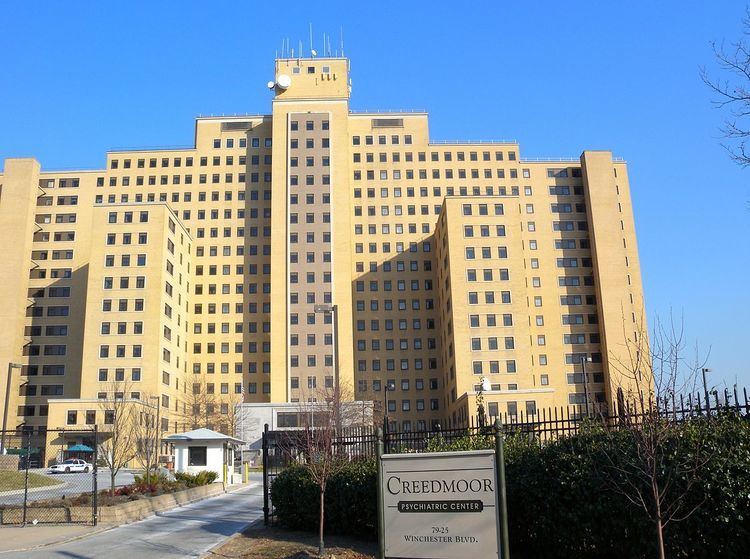Phone +1 718-464-7500 | Construction began 1912 | |
 | ||
Hours Open today · Open 24 hoursWednesdayOpen 24 hoursThursdayOpen 24 hoursFridayOpen 24 hoursSaturdayOpen 24 hoursSundayOpen 24 hoursMondayOpen 24 hoursTuesdayOpen 24 hours District New York State Office Of Mental Health School District Similar Bronx Psychiatric Center, Manhattan Psychiatric Center, Gracie Square Hospital, Calvary Hospital, Flushing Hospital Medical | ||
Mini popwing fpv flight at creedmoor psychiatric center
Creedmoor Psychiatric Center is a psychiatric hospital in Queens Village, Queens, New York, United States that provides inpatient, outpatient and residential services for severely mentally ill patients. The practical nurses and nurse assistants lived and worked on the property. The history of the hospital and its campus, which occupies more than 300 acres (1.2 km2) and includes more than 50 buildings, reflects both the urbanization of the borough of Queens, and a series of changes in psychiatric care.
Contents
- Mini popwing fpv flight at creedmoor psychiatric center
- The second floor at the living museum at creedmoor psychiatric center in queens new york
- Early history of the site
- History of the hospital
- Notable residents
- Programs
- References
The second floor at the living museum at creedmoor psychiatric center in queens new york
Early history of the site
The hospital's name derives from the Creeds, a family that previously farmed the site. The local railroad station on a line that ran from Long Island City to Bethpage took the name Creedmoor, apparently from the phrase “Creed’s Moor,” describing the local geography, In the early 1870s, New York State purchased land from the Creeds for use by the National Guard and by the National Rifle Association (NRA) as a firing range. The Creedmoor Rifle Range hosted prestigious international shooting competitions, which became the forerunner of the Palma Trophy competition. In 1892, as a result of declining public interest and mounting noise complaints from the growing neighborhood, the NRA deeded its land back to the state.
History of the hospital
In 1912, the Farm Colony of Brooklyn State Hospital was opened, with 32 patients, at Creedmoor by the Lunacy Commission of New York State, reflecting a trend towards sending the swelling population of urban psychiatric patients to the fresh air of outlying areas. By 1918, Creedmoor’s own census had swollen to 150, housed in the abandoned National Guard barracks. By 1959, the hospital housed 7,000 inpatients. Creedmoor is described as a crowded, understaffed institution in Susan Sheehan's Is There No Place On Earth For Me? (1982), a biography of a patient pseudonymously called Sylvia Frumkin. Dr. Lauretta Bender, child neuropsychiatrist, has been reported as practicing there in the 1950s and 1960s. In the late 1970s, one of its more notorious patients was former NYPD officer Robert Torsney, who was committed there in December, 1977 after being found not guilty by reason of insanity in the 1976 murder of then 15-year-old Randolph Evans in Brooklyn and was kept there until July, 1979 when reviewers declared him no longer a threat.
The hospital's census had declined by the early 1960s, however, as the introduction of new medications, along with the deinstitutionalization movement for many psychiatric patients. In 1975, the land in Glen Oaks formerly used to raise food for the hospital was opened to the public as the Queens County Farm Museum. Another part of the campus in Glen Oaks was developed into the Queens Children's Psychiatric Center. In 2004, the remaining part of Creedmoor land in Glen Oaks was developed into the Glen Oaks public school campus, including The Queens High School of Teaching. By 2006, other parts of the Creedmoor campus had been sold and the inpatient census was down to 470. A more recent portrayal of life in Creedmoor appears in Katherine Olson's Something More Wrong (2013).
There are several unused buildings on the property, including the long-abandoned Building 25. Many parts of the building are covered in bird guano, the largest pile being several feet high.
Notable residents
Musician Lou Reed and jazz pianist Bud Powell were treated at Creedmoor. Legendary folksinger Woody Guthrie, who had been institutionalized for years while suffering from Huntington's disease, was transferred to Creedmoor in June 1966 and died there in October 1967.
Programs
The hospital’s notable ventures include The Living Museum, which showcases artistic works by patients and is the first museum of its kind in the U.S.
